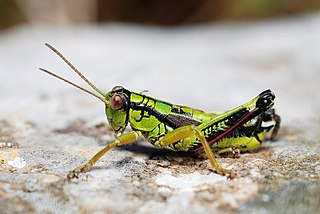
Miramella is a small genus of short-horned grasshoppers in the subfamily Melanoplinae. They are found in Europe and eastern Asia. As of January 2019, Orthoptera Species File lists seven species in three subgenera. The genus was first named in 1932. Miramella is the type genus of the subtribe Miramellina.
Sam W. Heads is a British palaeontologist, a Fellow of the Linnean Society of London, a Fellow of the Royal Entomological Society, as well as a former Officer and Editor-in-Chief at the Orthopterists' Society.
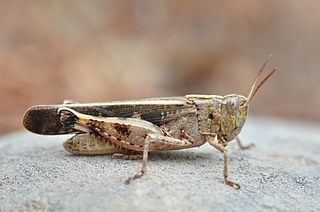
Aiolopus strepens is a species of grasshopper belonging to the family Acrididae, subfamily Oedipodinae.

Calliptamus siciliae, commonly known as the pygmy pincer grasshopper, is a species of short-horned grasshoppers belonging to the family Acrididae subfamily Calliptaminae.

Metaplastes pulchripennis, common name Italian ornate bush-cricket, is a species of 'katydids crickets' belonging to the family Tettigoniidae subfamily Phaneropterinae.

Pholidoptera fallax is a species of 'katydids crickets' belonging to the family Tettigoniidae subfamily Tettigoniinae.

Yersinella raymondii, common name Raymond's bush-cricket, is a species of "katydids crickets" belonging to the family Tettigoniidae subfamily Tettigoniinae. The scientific name Yersinella comes from the name of the entomologist who has described the species in 1860.

Conocephalus fuscus, the long-winged conehead, is a member of the family Tettigoniidae, the bush-crickets and is distributed through much of Europe and temperate Asia. This bush-cricket is native to the British Isles where it may confused with the short-winged conehead. These two species are phenotypically similar; however, the distinguishing factor between the two is the fully developed set of wings the long-winged conehead possesses that allows for flight. In the short-winged coneheads the hind wings are shorter than the abdomen, causing the wings to be vestigial and the species is incapable of flight. For this reason it is hard to discriminate between the two species during the early stages of their life cycle before the wings have fully developed. The colouration of the conehead is typically a grass green with a distinctive brown stripe down its back, though there are some brown phenotypes.

Stenobothrus rubicundulus, the wing-buzzing grasshopper, is a species of short-horned grasshoppers in the family Acrididae.
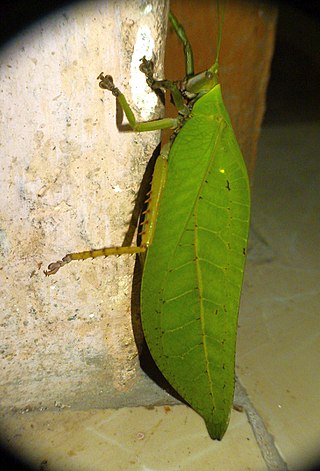
Onomarchus is a genus of bush crickets or katydids found mainly distributed in the tropical forests of Asia. Like many other members of the subfamily Pseudophyllinae, their wings appear very leaf-like.

Antaxius pedestris is a species of "bush crickets" belonging to the family Tettigoniidae. It was originally described by Johan Christian Fabricius under the scientific name of Locusta pedestris.

Brachytrupes megacephalus is a species of cricket in the family Gryllidae.

Grylloidea is the superfamily of insects, in the order Orthoptera, known as crickets. It includes the "true crickets", scaly crickets, wood crickets and other families, some only known from fossils.
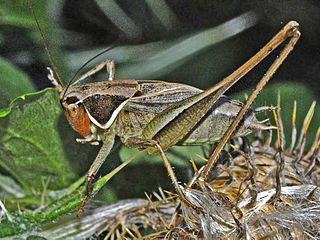
Sepiana sepium, common name sepia bush-cricket, is a species of bush crickets belonging to the tribe Platycleidini and genus group Platycleis. It is the only species within the monotypic genus Sepiana.

Leptophyes laticauda is a species of bush-crickets belonging to the family Tettigoniidae.
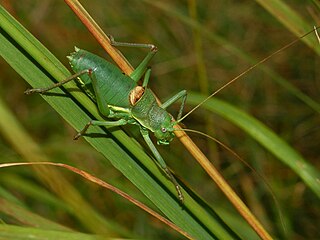
Ephippiger perforatus, the North Apennine saddle bush-cricket, is a species of insect in the family Tettigoniidae.
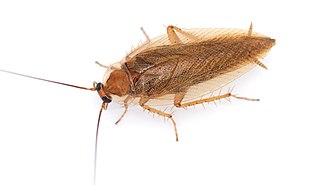
Ectobius vittiventris, the amber wood cockroach or amber forest cockroach, is a species belonging to the order Blattodea and is a type of wood cockroach originally from southern Europe. It is completely harmless to humans and is not a storage pest, as it only feeds on decomposing plant material and perishes within a few days in human dwellings due to a lack of food. Its original range was south of the Alps, but is now permanently established north of the Alps and in southern Germany.

Gryllotalpa unispina is a species of mole cricket, in the G. gryllotalpa species group, found in Eastern Europe through to Manchuria. No subspecies are listed in the Catalogue of Life.
Gomphoceridius is a monotypic genus of grasshoppers containing the species Gomphoceridius brevipennis and placed in the subfamily Gomphocerinae, tribe Gomphocerini.
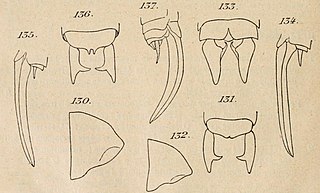
Conocephalus conocephalus is the type species of the conehead genus Conocephalus and the bush cricket tribe Conocephalini. This species has been recorded from southern Europe, including France, and Africa. Described by Carl von Linné in 1767, C. conocephalus appears to have no surviving type specimens, although it is believed that material may have been obtained from Africa.




















